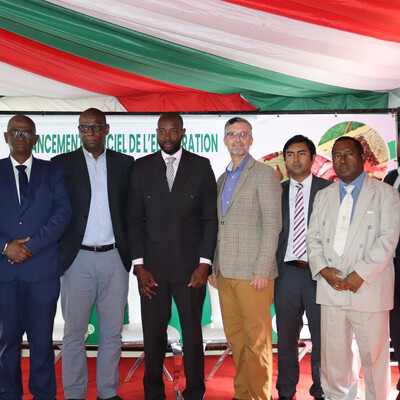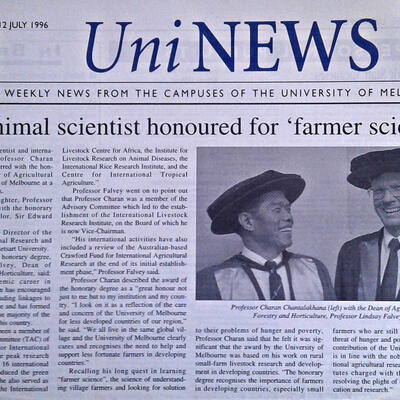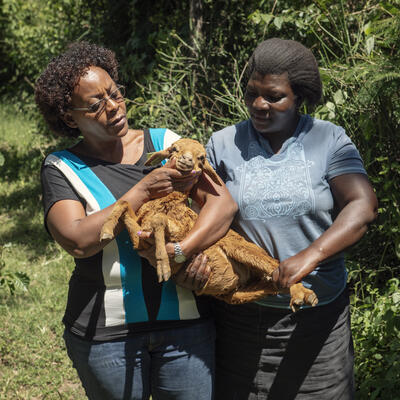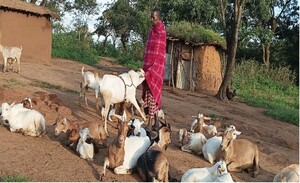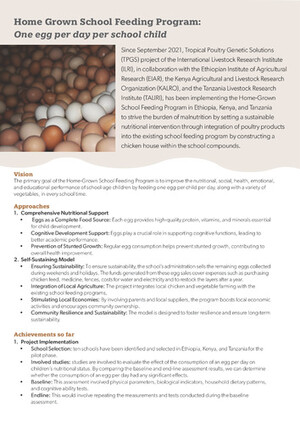
Private sector embedded extension model sustains field activities during COVID-19 pandemic
Measuring weight of animal to determine appropriate dosage for ECF vaccine and dewormer in Muhoroni subcounty, Kisumu County, Kenya (photo credit: AVCD Dairy).
Update from the dairy component of the AVCD program
In the last three months (April- June), the dairy component of the Accelerated Value Chain Development (AVCD) program has been able to continue implementing field activities with minimal disruption despite the challenges occasioned by COVID-19. The continued field activities could be credited to the success of private sector embedded extension model, popularly known as the dairy farmer assistant model.
The dairy farmer assistants (DFAs) are technical personnel trained in animal health and production, among other skills and are residents in the local community. Their local residence coupled with classification of most of their services as essential has enabled them to continue with service delivery to the farmers. These local extension structures have helped sustain the implementation of some activities, and improved field activity monitoring and support to farmer producer organisations (FPOs) despite the pandemic. At the same time, the AVCD dairy technical team maintains communication with DFAs – using voice calls, messaging platforms like WhatsApp and virtual meetings on Google Hangouts – to review activity implementation, thus sustaining several field activities of the dairy component. With the reduced communal engagement occasioned by the pandemic, the DFAs use one-on-one interactions during farm visits to mobilize farmers for technology dissemination.
Through these farm visits, the DFAs have continued to offer training to farmers on several dairy modules, reaching more than 600 farmers during the three months of restricted movement. Farmers have been trained on breed improvement, feed and fodder establishment, feeding, and calf rearing. Through an online data platform developed by AVCD, trained artificial insemination (AI) service providers who have information and communication technology (ICT) skills have been able to report breeding events in real-time.
The digital data reporting has enabled the county directorate to monitor breeding activities on a real-time basis leading to efficiency in the delivery of breeding services to farmers. The ongoing training has also enabled mobilization of animals for interventions, culminating in synchronized breeding (FTAI) of 867 animals and vaccination of 472 animals against East Coast fever. Also, 1,043 acres of land have been set aside for fodder production, particularly Brachiaria.
Through virtual meetings, the AVCD team has also engaged the county of Busia to commit resources to breeding initiatives. This has resulted into a partnership between AVCD, the county government of Busia and Send A Cow. Under this partnership, AVCD provides reproductive hormones, Send A Cow supplies semen for breeding work while the county Directorate of Veterinary Services coordinates mobilization of farmers and supervises the fixed-time artificial insemination (FTAI) exercise.
The first set of 22 animals were reached with the FTAI under this partnership the week of June 15th, and we expect more by the end of June. Other interventions which were carried out at farm level included spraying, treatment of clinical cases, deworming, vaccinations against diseases such as foot-and-mouth disease (FMD), milk hygiene training and teat dips among others. Due to movement restrictions, the dairy component has focused on supporting activities that do not require physical movement (i.e. the development of a human resource policy for Kasbondo, SAM Malanga, Seke, Rongo and Rangwe producer organizations). The policies have been submitted to the boards of management of the cooperatives for input.
Additional progress has been made in the development of county dairy development strategies. AVCD is collaborating with the Kenya Dairy Board and county governments to support seven county governments to develop county dairy development strategies. After initial stakeholder and technical forums, which involved collection and synthesis of baseline data, drafting of county dairy development strategies has begun. Stakeholder meetings to validate the draft are planned after the COVID-19-related restrictions are lifted. However, business support to dairy cooperatives and conducting county dairy development forums have been suspended.
The effect of limited technical support to cooperatives is already emerging, as exemplified by the decline in business sales and spur-of-the-moment decision-making. For example, Kaiti dairy cooperative located in Makueni county collected an average of 700 liters per day before the COVID 19 pandemic with their main milk market being institutions such as schools and restaurants. Due to government efforts to contain the spread of the virus closure of these institutions effectively locking Kaiti dairy out of their market. The cooperative currently collects only 320 liters of milk. As a result of the shrinking market, the dairy has had to turn away some of their milk suppliers. Additionally, the cooperative has a campaign urging their members to cut milk production through reduction on concentrate feeding to ensure members only produce what they can consume or sell to their neighbours.
Similarly, implementing the dairy component activities through existing county government structures has enabled nutrition activities to continue in the physical absence of AVCD in the field. The dairy component applies the community health strategy approach by engaging community health volunteers (CHVs) to pass nutrition messages, using community dialogue cards, to dairy farmers. While the CHVs pass COVID-19 prevention messages to the community members, they have, simultaneously, integrated agri-nutrition messages to educate and raise awareness to caregivers and other family members.
Through this approach, the CHVs have reached 201 children under the age of two years in Siaya and Homa Bay counties. To strengthen capacities to implement agri-nutrition in the implementing counties, the project is organizing, with the Migori County, to train 30 more CHVs and 8 DFAs and community facilitators on agri-nutrition to strengthen community nutrition messages among dairy farmers. Virtual review meetings are being held with the county officials to discuss challenges and opportunities to improve dietary consumption and infant and young childcare and feeding practices. Also, to support nutrition advocacy efforts, county nutrition fact sheets are being developed virtually for Busia, Kisumu and Migori counties. The AVCD nutrition team is also giving technical supporting to the county teams including in setting up virtual meetings to develop the county nutrition fact sheets.









